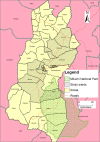Self-medication with anti-malarials is a common practice in rural communities of Kilosa district in Tanzania despite the reported decline of malaria
- PMID: 24992941
- PMCID: PMC4087197
- DOI: 10.1186/1475-2875-13-252
Self-medication with anti-malarials is a common practice in rural communities of Kilosa district in Tanzania despite the reported decline of malaria
Abstract
Background: Self-medication has been widely practiced worldwide particularly in developing countries including Tanzania. In sub-Saharan Africa high incidences of malaria have contributed to self-medication with anti-malarial drugs. In recent years, there has been a gain in malaria control, which has led to decreased malaria transmission, morbidity and mortality. Therefore, understanding the patterns of self-medication during this period when most instances of fever are presumed to be due to non-malaria febrile illnesses is important. In this study, self-medication practice was assessed among community members and information on the habit of self-medication was gathered from health workers.
Methods: Twelve focus group discussions (FGD) with members of communities and 14 in-depth interviews (IDI) with health workers were conducted in Kilosa district, Tanzania. The transcripts were coded into different categories by MaxQDA software and then analysed through thematic content analysis.
Results: The study revealed that self-medication was a common practice among FGD participants. Anti-malarial drugs including sulphadoxine-pyrimethamine and quinine were frequently used by the participants for treatment of fever. Study participants reported that they visited health facilities following failure of self-medication or if there was no significant improvement after self-medication. The common reported reasons for self-medication were shortages of drugs at health facilities, long waiting time at health facilities, long distance to health facilities, inability to pay for health care charges and the freedom to choose the preferred drugs.
Conclusion: This study demonstrated that self-medication practice is common among rural communities in the study area. The need for community awareness is emphasized for correct and comprehensive information about drawbacks associated with self-medication practices. Deliberate efforts by the government and other stakeholders to improve health care services, particularly at primary health care facilities will help to reduce self-medication practices.
Figures
Similar articles
-
How sulfadoxine-pyrimethamine (SP) was perceived in some rural communities after phasing out chloroquine (CQ) as a first-line drug for uncomplicated malaria in Tanzania: lessons to learn towards moving from monotherapy to fixed combination therapy.J Ethnobiol Ethnomed. 2006 Jan 10;2:5. doi: 10.1186/1746-4269-2-5. J Ethnobiol Ethnomed. 2006. PMID: 16403225 Free PMC article.
-
Community knowledge and attitudes and health workers' practices regarding non-malaria febrile illnesses in eastern Tanzania.PLoS Negl Trop Dis. 2014 May 22;8(5):e2896. doi: 10.1371/journal.pntd.0002896. eCollection 2014 May. PLoS Negl Trop Dis. 2014. PMID: 24852787 Free PMC article.
-
Factors determining anti-malarial drug use in a peri-urban population from malaria holoendemic region of western Kenya.Malar J. 2010 Oct 26;9:295. doi: 10.1186/1475-2875-9-295. Malar J. 2010. PMID: 20977741 Free PMC article.
-
Saleability of anti-malarials in private drug shops in Muheza, Tanzania: a baseline study in an era of assumed artemisinin combination therapy (ACT).Malar J. 2011 Aug 15;10:238. doi: 10.1186/1475-2875-10-238. Malar J. 2011. PMID: 21843328 Free PMC article.
-
Medicine sellers and malaria treatment in sub-Saharan Africa: what do they do and how can their practice be improved?Am J Trop Med Hyg. 2007 Dec;77(6 Suppl):203-18. Am J Trop Med Hyg. 2007. PMID: 18165494 Free PMC article. Review.
Cited by
-
Community-Based Malaria Testing Reduces Polypharmacy in a Population-Based Survey of Febrile Illness in Western Kenya.Int J Public Health. 2022 Aug 25;67:1604826. doi: 10.3389/ijph.2022.1604826. eCollection 2022. Int J Public Health. 2022. PMID: 36090831 Free PMC article. Clinical Trial.
-
Determinants of treatment-seeking behavior during self-reported febrile illness episodes using the socio-ecological model in Kilombero District, Tanzania.BMC Public Health. 2021 Jun 5;21(1):1075. doi: 10.1186/s12889-021-11027-w. BMC Public Health. 2021. PMID: 34090402 Free PMC article.
-
Pre-hospital exposures to antibiotics among children presenting with fever in northern Uganda: a facility-based cross-sectional study.BMC Pediatr. 2022 Jun 1;22(1):322. doi: 10.1186/s12887-022-03375-2. BMC Pediatr. 2022. PMID: 35650548 Free PMC article.
-
Knowledge, use (misuse) and perceptions of over-the-counter analgesics in sub-Saharan Africa: a scoping review.Glob Health Action. 2021 Jan 1;14(1):1955476. doi: 10.1080/16549716.2021.1955476. Glob Health Action. 2021. PMID: 34420494 Free PMC article.
-
Challenges in Diagnosing and Treating Acutely Febrile Children with Suspected Malaria at Health Care Facilities in the Lake Mwanza Region of Tanzania.Am J Trop Med Hyg. 2023 Dec 26;110(2):202-208. doi: 10.4269/ajtmh.23-0254. Print 2024 Feb 7. Am J Trop Med Hyg. 2023. PMID: 38150741 Free PMC article.
References
-
- WHO. Guidelines for the regulatory assessment of medicinal products for use in self-medication. Geneva: WHO/EDM/QSM00.1 World Health Organization; 2000.
-
- Geissler PW, Nokes K, Prince RJ, Achieng’Odhiambo R, Aagaard-Hansen J, Ouma JH. Children and medicines: self-treatment of common illnesses among Luo schoolchildren in western Kenya. Soc Sci Med. 2000;50:1771–1783. - PubMed
-
- Awad A, Eltayeb I, Matowe L, Thalib L. Self-medication with antibiotics and antimalarials in the community of Khartoum State, Sudan. J Pharm Pharm Sci. 2005;8:326–331. - PubMed
-
- Nsimba SED, Rimoy GH. Self-medication with chloroquine in a rural district of Tanzania: a therapeutic challenge for any future malaria treatment policy change in the country. J Clin Pharm Ther. 2005;30:515–519. - PubMed
Publication types
MeSH terms
Substances
LinkOut - more resources
Full Text Sources
Other Literature Sources


